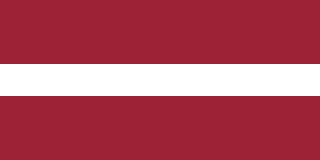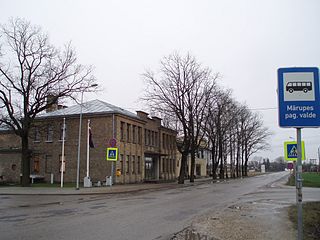
Riga is the capital and largest city of Latvia and is home to 605,802 inhabitants which is a third of Latvia's population. It is also the second largest city in the three Baltic states after Vilnius and is home to one tenth of the three Baltic states' combined population. The city lies on the Gulf of Riga at the mouth of the Daugava river where it meets the Baltic Sea. Riga's territory covers 307.17 km2 (118.60 sq mi) and lies 1–10 m (3.3–32.8 ft) above sea level, on a flat and sandy plain.

Riga International Airport is the international airport of Riga, the capital of Latvia, and the largest airport in the Baltic states with direct flights to 76 destinations as of November 2019. It serves as a hub for airBaltic, SmartLynx Airlines and RAF-Avia, and as one of the base airports for Wizz Air. The Latvian national carrier airBaltic is the largest carrier that serves the airport, followed by Ryanair. The airport is located in the Mārupe Municipality west of Riga, approximately 10 km from its city centre.

Riga Technical University (RTU) is the oldest technical university in the Baltic countries established on October 14, 1862. It is Located in Riga, Latvia and was previously known as Riga Polytechnical Institute and Riga Polytechnicum.

Līvāni is a town in Līvāni Municipality in the Latgale region of Latvia. It is situated at the junction of the Dubna and Daugava rivers, approximately 170 kilometers east of Riga, the capital.

The following outline is provided as an overview of and topical guide to transport:

Maskavas Forštate also known as Maskavas priekšpilsēta and colloquially as Maskačka, is a suburb of Riga situated on the right bank of the Daugava. The neighborhood is located to the south of Old Riga along the road historically connecting Riga to Moscow, from which its name is derived.

The rail transport system in Estonia consists of about 1,200 kilometres (750 mi) of railway lines, of which 900 kilometres (560 mi) are currently in public use. The infrastructure of the railway network is mostly owned by the state and is regulated and surveyed by the Estonian Technical Surveillance Authority.

Rīgas Satiksme is a municipally-owned public transportation and infrastructure company serving Riga, Latvia and the surrounding areas. It was founded on 20 February 2003 as an umbrella organisation for the respective operators of trams, buses and trolleybuses in the city of Riga. Two years later, the separate operators of the different modes of public transport were merged and re-branded to its current name.

Rail transport in Latvia is done on 1,520 mm Russian gauge. The main railway company is the state-owned Latvijas dzelzceļš (LDz), with its subsidiary Pasažieru vilciens (PV) providing passenger services.

JSC Latvian Railway was established on 2 September 1991 and is seen as the successor of the Latvian Railway Board which was established on 5 August 1919.

The following outline is provided as an overview of and topical guide to Latvia:

Rail Baltica is a high-speed railway under construction between Warsaw, Poland and Tallinn, Estonia, with further connections to Finland via Baltic Sea cruiseferries or the proposed Helsinki–Tallinn Tunnel. Trains will operate at top speeds of 234 km/hour. Travel time between Vilnius and Tallinn is projected to be 3.5 hours and travel times between Riga and either Vilnius or Tallinn will be under 2 hours. It is projected to shift travel and transportation from roads to rail and have numerous benefits on economies and quality of life. Trains are predicted to begin operating on various sections of the route at various times between 2026 and 2030.

Riga Central Station is the main railway station in Riga, Latvia. It is known as the main point of Riga due to its central location, and most forms of public transport stop in this area. Part of the building is a shopping centre.

The Railway Bridge is a bridge that crosses the Daugava river in Riga, the capital of Latvia.

Uldis Augulis is a Latvian politician and a member of the Union of Greens and Farmers. He holds a bachelor's degree in financial management from the University of Latvia. He was the former Welfare Minister from 12 March 2009 to 3 November 2010, the Minister of Transport from 3 November 2010 to 25 October 2011 and the acting Minister of Justice from March to April 2010. Augulis was elected to the Saeima on October 2, 2011.

The Riga–Daugavpils railway line is a 218-kilometre (135 mi) long railway line in Latvia which connects the cities of Riga in central Latvia and Daugavpils in south-eastern Latvia.

Mārupe is a town in and the centre of Mārupe Municipality, Latvia. Mārupe is in practice a suburb of the Latvian capital, Riga, and is the headquarters of the Latvian Bandy Federation. A small river Mārupīte flows through the town.
Current plans call for a high-speed Rail Baltica that will connect the Latvian capital Riga with Pärnu and Tallinn to the north and with Kaunas and Warsaw to the south. Reports in March 2011 indicate plans are moving towards a standard gauge railway.
This page is based on this
Wikipedia article Text is available under the
CC BY-SA 4.0 license; additional terms may apply.
Images, videos and audio are available under their respective licenses.























